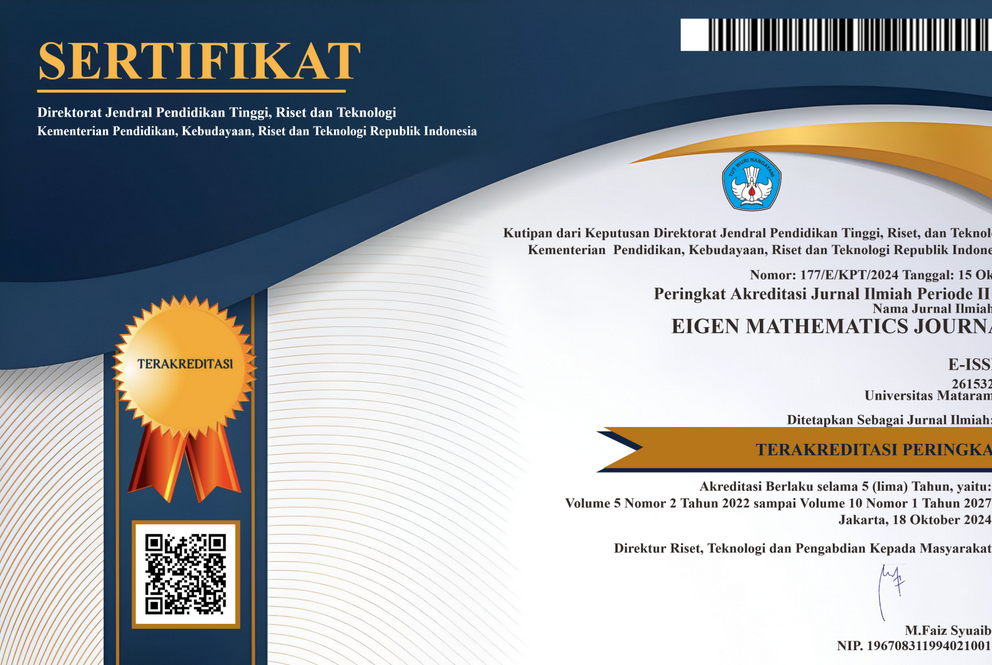Solution of The Duffing Equation Using Exponential Time Differencing Method
DOI:
https://doi.org/10.29303/emj.v7i1.195Abstract
To describe the spring stiffening effect that occurs in physics and engineering problems, Georg Duffing added the cubic stiffness term to the linear harmonic oscillator equation and is now known as the Duffing oscillator. Despite its simplicity, its dynamic behavior is very diverse. In this research, the Exponential Time Difference method is introduced to solve the Duffing oscillator numerically. To formulate the ETD method, we were using the integration factors. It is a function which, when multiplied by an ordinary differential equation, produces a differential equation that can be integrated. This method is an effective numerical method for solving complex differential equations, especially equations that have strong non-linearity The ETD method delivers highly accurate numerical solutions for the Duffing oscillator, with minimal discrepancy from the analytical results. Through parameter variation, the ETD method's applicability extends to diverse Duffing oscillator configurations.References
Adams, R. A. (2003). Calculus: A Complete Course. Addison Wesley.
C. Pezeshki, E. D. (1987). An examination of initial condition maps for the sinusoidally excited buckled beam modeled by the Duffing's equation. Journal of Sound and Vibration, 117(2), 219-232.
Chen, Y. (2002). Solution of the Duffing equation by using target function method. Journal of Sound and Vibration, 256(3), 573-578.
Duffing, G. (1918). Erzwungene Schwingungen bei veränderlicher Eigenfrequenz und ihre technische Bedeutung. Braunschweig: Vieweg.
Feng, Z. (2003). Duffing's equation and its applications to the Hirota equation. Physics Letters A, 317(1–2), 115-119.
Gregory Beylkin, J. M. (1998). A New Class of Time Discretization Schemes for the Solution of Nonlinear PDEs. Journal of Computational Physics, 147(2), 362-387.
Johannessen, K. (2014). An analytical solution to the equation of motion for the damped nonlinear pendulum. Eur. J. Phys., 35(3).
Johannessen, K. (2015). The Duffing oscillator with damping. Eur. J. Phys., 36(6).
S.M. Cox, P. M. (2002). Exponential Time Differencing for Stiff Systems. Journal of Computational Physics, 176(2).
Tabatabaei, K., & Gunerhan, E. (2014). Numerical solution of Duffing equation by the differential transform method. Appl. Math. Inf. Sci. Lett, 2(1), 1-6.
Wang, Z. (2005). P-stable linear symmetric multistep methods for periodic initial-value problems. Computer Physics Communications, 171(3), 162-174.
Yusufoğlu, E. (2006). Numerical solution of Duffing equation by the Laplace decomposition algorithm. Applied Mathematics and Computation, 177(2), 572-580.
Downloads
Published
How to Cite
Issue
Section
License

This work is licensed under a Creative Commons Attribution-NonCommercial-ShareAlike 4.0 International License.
All articles published in the Eigen Mathematics Journal will be available for free reading and downloading. The license applied to this journal is Creative Commons Attribution-Non-Commercial-Share Alike (CC BY-NC-SA).






